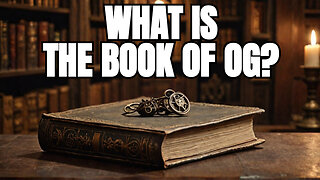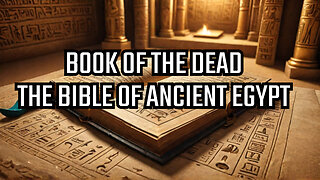Audiobook: Revolt Against the Modern World by Julius Evola, Part Two, Chapter 30-1
Chapter 30: The Heroic-Uranian Western Cycle, Part 1
THE HELLENIC CYCLE
In this detailed exploration of the Hellenic and Roman cycles, we delve into the heroic and spiritual transformations that shaped ancient civilizations. Evola examines the distinct phases of Hellenic culture, from the sacred foundations of the Olympian and Hyperborean ideals to the eventual rise of democratic and antitraditional elements. Similarly, the Roman cycle is analyzed as a powerful reaction against Mediterranean decadence, culminating in the creation of a grand and universal empire. This video provides an in-depth look at the cultural, spiritual, and historical dynamics that defined these ancient societies.
Footnotes:
1. Herodotus (.Histories 1.56; 8.44) regarded the early Ionian inhabitants of Athens as Pelasgians and called their language “barbarous/’ that is, non-Hellenic.
2. W. Ridgeway, The Early Age of Greece (Cambridge, 1901), 1.337-406; 407, 541. This work contains several valuable insights regarding the separation of the Nordic component from the Pelasgic component within Hellenic civilization, even though the author emphasizes the ethnic more than the spiritual opposition between these components.
3. Callimachus. Hymn to Zeus. 5.9.
4. Herodotus, Histories, 2.50. There are two traditions concerning the Pelasgian Minos: in the first he appears as a just king and as a divine legislator (his name has an interesting etymological similarity to the Hindu Manu, the Egyptian Manes, the Germanic Mannus, and maybe the Latin Numa); in the second he appears as a violent and demonic power ruling over the waters. The opposition between the Hellenes and Minos refers to the latter tradition.
5. Thus wrote Bachofen: “Gynaecocracy is part of the legacy of those races that Strabo (7.321; 7.572) regarded as barbarous and as the early pre-Hellenic inhabitants of Greece and of Asia Minor, whose repeated migrations began ancient history just as the migratory waves of northern populations during later times began the history of our times." Mutterrecht, 43. Another historian, Domenico Mosso (Origini della civilta’ mediterranea, 128) showed that the priestesses of the sarcophagus of Hagia Triada were in charge of the most important functions of the priesthood, while men only had a secondary role in it. Mosso also indicated that the Minoan-Pelasgian religion retained its matriarchical character for a long time and that the privileged status of women, not only in the rites but also in social life (Escursioni nel Mediterraneo, 216,221), characterized both the Minoan and the Etruscan civilizations.
6. The Olympian Zeus, after defeating the Titans and their allies, confined them to Tartarus or Erebus, which is the location where “Atlas” was kept prisoner and also the seat of Hecate, one of the forms of the Pelasgian Goddess.
7. See J.E. Harrison, Prolegomena to the Study of Greek Religion (Cambridge, 1903),4-10; 120; 162. In this work there are several valid observations regarding the opposition between an Achaean Olympian ritual and a chthonic ritual within the Greek religion.
8. See Ridgeway, Early Age of Greece (506 ff.; 521-25), which shows the opposition between the cremation practices of northern Aryan origin and the burial practices of Greek-Pelasgic origin; this difference reflects the Uranian and the telluric views of the afterlife. The cremation of corpses was practiced by those who wanted to remove once and for all the psychic residues of the “deceased,” since these residues were regarded as baleful influences, or by those who imagined for the sou! of the “hero” a dwelling totally removed from the earth; this dwelling could be reached only after the last connection with the living (i.e., the corpse) was destroyed as if through an extreme purification. The burial ritual expresses the return of “earth to earth" and the dependency on the origins conceived in a telluric fashion. In Homer's times this ritual was virtually unknown, just like the idea of a "hell” and its torments.
9. Herodotus (Histories, 2.81) did not distinguish Orpheus from Bacchus; if Dio (Roman History) relates the modifications Orpheus allegedly introduced into the orgiastic rituals, this may be a modification in a Pythagorean sense (Orpheus as musician, or the idea of harmony), which, however, did not alter its fundamental character. According to some Orpheus came from Crete, that is from an Atlantic-Pelasgic center, others, by identifying him with Pythagoras himself, see him as a descendant of the Atlanteans.
10. Harrison (Prolegomena to the Study of Greek Religion, 120; 162) identified those festivals in which the feminine theme was predominant with the forms of magical rituals of purification that were typical of the ancient chthonic cult; it is likely that they constituted the germ of a certain aspect of the Mysteries. The notion of purification and expiation, which was virtually unknown in the Olympian cult, was a dominant theme in the inferior stratum. Later on, some kind of compromise and sublimation took place. Once the aristocratic idea of divinity as a natural state was lost (the heroes were mainly such by virtue of their divine origins), what ensued was the idea of a mortal man who yearned for immortality; then the ancient magical and exorcising motif of purification and of expiation was assumed in the mystical form of “purification from death,” and finally in the form of a moral purification and expiation, as in the decadent aspects of the Mysteries that presaged Christianity.
11. Bachofen (Mutterrecht, 247-49) has brought to light an interesting thing, namely, that popular tyrants usually derived their power from a woman and succeeded each other according to a feminine line. This was one of signs of the relationship between democracy and gynaecocracy that is noticeable even in the cycle of the foreign kings in Rome.
12. According to some, Pythagoras owed his doctrine to the teaching of a woman, Themistoclea (Diogenes Laertius, Life of Pythagoras, 5). He entrusted some women to teach doctrine, since he acknowledged their greater propensity to the divine cult; his community had forms that remind us of matriarchy (ibid., 21, 8). Pliny (Natural History, 36.46) mentions that Pythagoras’s disciples started to practice again the chthonic ritual of burial.
13. If we keep in mind the "Dionysization” undergone by the cult of Apollo in Delphi, which led to the introduction of an anti-Olympian ritual of prophecies uttered through ecstatic or delirious women—then the very same traditions that tend to establish a relationship between Pythagoreanism and Apollonism (Pythagoras as “the one who leads the Pythia,” or Pythagoras being identified with Apollo through his “golden thigh,” etc.) hardly contradict what has just been said.
14. Delphi’s value of “pole” was obscurely perceived by the Hellenes since they regarded Delphi as the omphalos, or the “center” of the earth and of the world; in any event, they found in the Delphic amphitrionate the sacred bond that united them over and above the particularism of the individual city-states.
15. It is significant that Apollonian Delphi, the traditional centerofancient Hellas, did not hesitate to abandon the "national cause" when it came in contact with civilizations that expressed the same spirit that it itself embodied, such as in the fifth century, in favor of the Persians, and in the fourth century in favor of the Macedonians. The Persians, for their part, almost recognized their god in the Hyperborean Apollo; in Hellenism we often encounter the assimilation of Apollo to Mithras, and on the part of the Persians, of Ahura Mazda to Zeus, of Verethragna to Heracles, of Anahita to Artemis, and so on. This was much more than mere “syncretism."
16. In India, Buddhism opposed pragmatism and realism to priestly philosophical speculations around the same time the early Greek philosophers appeared on the scene.
17. Some, like Protagoras, claimed that "Man is the measure of all things" and employed this hermeneutical principle in an individualistic, destructive, and sophistical way.
18. I employ this term according to the sense that Michelstaedter (La persuasions e la retorica [Florence. C. 1922]) gave to it; he vividly illustrated the sense of Socratic conceptual decadence and philosophical evasiveness vis-i-vis the doctrine of “being" as defended by the Eleatics.
19. Gellius, 18.7.3.
-
 29:48
29:48
Dangerous reads
5 days agoAudiobook: Revolt Against the Modern World by Julius Evola, Part Two, Chapter 29-1
39 -
 17:39
17:39
Dangerous reads
6 days agoAudiobook: Revolt Against the Modern World by Julius Evola, Part Two, Chapter 27
301 -
 51:07
51:07
The Jeremy Ryan Slate Show
8 days ago $0.18 earnedAncient Secrets to Fixing Our Broken Society, Feat. Alex Petkas
2223 -
 24:46
24:46
CatholicReboot
17 days ago $0.01 earnedEpisode 2213: Books of the Bible - Sirach (Ecclesiasticus)
161 -
 35:45
35:45
The 5th Kind
16 days agoThe Book of the Secrets of Enoch | Mauro Biglino - The Bible, Anunnaki Gods , Elohim & The Nephilim
1.63K2 -
 11:16
11:16
MicrophoneTherapy
25 days agoWe Learn About The Forbidden Book of Og
41 -
 48:58
48:58
KJVStream
1 month agoEl Primer Libro de Corintios, Biblia Reina Valera Gómez (RVG) Ilustrada con AI (V1)
31 -
 12:51
12:51
MicrophoneTherapy
24 days agoWe Learn About the Egyptian Book of the Dead
35 -
 2:24:23
2:24:23
KJVStream
25 days agoThe Book of Leviticus, King James Version (KJV) Illustrated by AI (V1)
58 -
 17:59
17:59
BiblicalGold
8 days agoThe Vison of Paul part 6
261